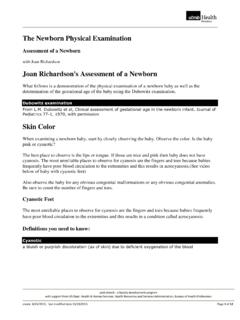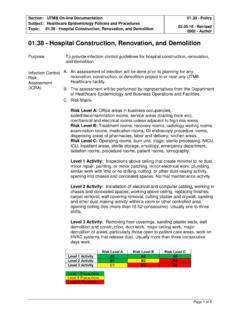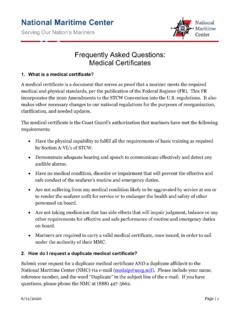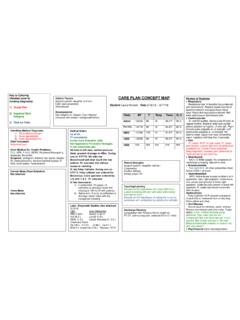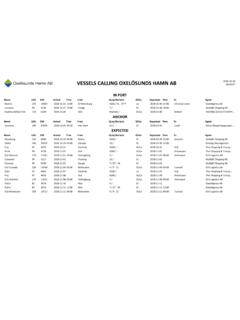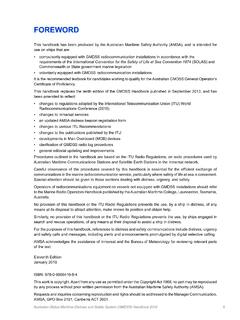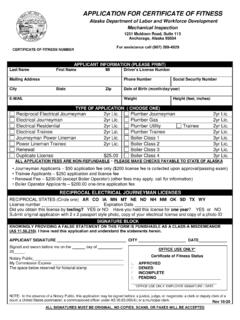Transcription of Chest Physiotherapy - UTMB
1 utmb RESPIRATORY CARE SERVICES PROCEDURE - Chest Physiotherapy Policy Page 1 of 10 Chest Physiotherapy Formulated: 11/78 Effective: 10/12/94 Revised: 04/05/18 _____ Continued next page Chest Physiotherapy Purpose To standardize the use of Chest Physiotherapy as a form of therapy using one or more techniques to optimize the effects of gravity and external manipulation of the thorax by postural drainage, percussion, vibration and cough. A mechanical percussor may also be used to transmit vibrations to lung tissues. Policy Respiratory Care Services provides skilled practitioners to administer Chest Physiotherapy to the patient according to physician s orders.
2 Accountability/Training Chest Physiotherapy is administered by a Licensed Respiratory Care Practitioner trained in the procedure(s). Training must be equivalent to the minimal entry level in the Respiratory Care Service with the understanding of age specific requirements of the patient population treated. Physician's Order A written order by a physician is required specifying: Frequency of therapy. Lung, lobes and segments to be drained. Any physical or physiological difficulties in positioning patient. Cough stimulation as necessary. Type of supplemental oxygen, and/or adjunct therapy to be used. Indications This therapy is indicated as an adjunct in any patient whose cough alone (voluntary or induced) cannot provide adequate lung clearance or the mucociliary escalator malfunctions.
3 This is particularly true of patients with voluminous secretions, thick tenacious secretions, and patients with neuro-muscular disorders. Drainage positions should be specific for involved segments unless contraindicated or if modification is necessary. Drainage usually in conjunction with breathing exercises, techniques of percussion, vibration and/or suctioning must have physician's order. NOTE: Therapy must be designed specific to the patient and his immediate problem - a therapy that is brief, effective and safe. Diseases frequently requiring postural drainage: bronchiectasis, cystic fibrosis, COPD, bronchitis, lung abscess. Contrain-dications Absolute contraindication Untreated tension pneumothorax utmb RESPIRATORY CARE SERVICES PROCEDURE - Chest Physiotherapy Policy Page 2 of 10 Chest Physiotherapy Formulated: 11/78 Effective: 10/12/94 Revised: 04/05/18 _____ Continued next page Contrain-dications Continued Prone, supine and/or Trendelenburg positions may not be tolerated in a patient with the following conditions: Check with the physician.
4 Unstable cardiovascular disorders: arrhythmias, hypotension, hypertension, organic heart disease, congestive heart failure, and pulmonary edema. Acute head or neck surgery/injury or disease: increased intracranial pressure, increased edema around airway. Dyspnea: orthopnea, severe lung disease, pulmonary emboli, large pleural effusion, anxiety, angina. Undiagnosed Chest pain. Chronic obstructive pulmonary disease with cor pulmonale, orthopnea, dyspnea on exertion. Active cases of tuberculosis Pulmonary edema, congestive heart failure. Distended abdomen, pregnancy, obesity, and ascites. Severe surgical emphysema. Neuromuscular disease Aneurysm or decrease in circulation of main blood vessels.
5 Post eye surgery. Hiatal hernia, esophageal anastomosis. Hemoptysis. Neonate prone to intracranial bleeding. Pain or discomfort restricting patient's cooperation. Vomiting Surgically undrained empyema. Careful positioning is indicated in patients with: Fractures. Recent spine surgery. Broncho-pleural fistula (keep involved side down). Immediate post-op pneumonectomy. Certain orthopedic injuries/surgeries. Vigorous Chest percussion is relatively contraindicated in patients with the following problems: Acute medical/surgical emergencies, poor or unstable cardiovascular disorders. Fragile, fractured ribs or osteoporosis, or extremely unstable Chest wall.
6 Fresh burns, skin grafts or infection on thorax. Acute bronchospasm, untreated. Incision or trauma to Chest or upper abdomen. Recent spinal fusion or surgery. Pulmonary emboli. utmb RESPIRATORY CARE SERVICES PROCEDURE - Chest Physiotherapy Policy Page 3 of 10 Chest Physiotherapy Formulated: 11/78 Effective: 10/12/94 Revised: 04/05/18 _____ Continued next page Temporary transvenous pacemaker Resectable pulmonary tumors (percussion usually not done over tumor) Pain preventing patient's cooperation. Extra parenchymal complications (pneumothorax, pleural effusion, empyema). Subcutaneous emphysema.
7 Untreated pneumothorax. Acute lung abscess. Simulated cough is relatively contraindicated in the following cases: Suspected or real intra-abdominal injury, disorder, bleeding, recent surgery. Organomegaly. Pregnancy. Diaphragm injury or surgery. Goals To improve the mobilization of bronchial secretions and the matching of ventilation and perfusion to normalize functional residual capacity (FRC). (If patient has any of these contraindications, the Respiratory Therapist is responsible for calling doctor to make appropriate changes on order or even discontinue therapy due to these contraindications) Equipment Tilt bed and/or pillows Towels or thick pad Sputum cup/tissue Stethoscope Manual, pneumatic, or vibratory percussor Procedure Step Action 1 Verify physician's orders and identify patient using two identifiers.
8 2 Collect needed equipment. 3 Wash hands. 4 Explain procedure and rationale to the patient. 5 Check patient's pulse and respiratory rate. Auscultate Chest . 6 Position patient according to segmental drainage chart. Allow 30-45 minutes after patient's completion of a meal. utmb RESPIRATORY CARE SERVICES PROCEDURE - Chest Physiotherapy Policy Page 4 of 10 Chest Physiotherapy Formulated: 11/78 Effective: 10/12/94 Revised: 04/05/18 _____ Continued next page 7 If patient's status does not allow full positioning, position him as close as possible to proper angle. ( , use pillows under hips if patient will not tolerate Trendelenburg.)
9 If position still is not tolerated, try positioning patient flat). Inform physician if positions are not tolerated. 8 Place folded towel or thick pad across patient's Chest over area to be percussed (adults and older children). 9 Cup hands with fingers and thumbs closed, use mechanical percussor, or use neonatal percussor on premature infants. Begin percussion over lung segment by flexion and extension of wrists. The therapist's shoulders and elbows should be relaxed. Can also use the ambu bag mask with medical tape occluding hole to percuss patient. Added Change 10 Percuss back and forth or in a circular motion, not continuously over one spot. Avoid spine, kidneys, base of the rib cage, and bony prominences such as sternum, clavicle, spine, and over scapula.
10 Use caution in areas of breast. 11 Force of percussion and length of time must be tailored to individual patient according to the patient's age, condition of Chest , tolerance, pain, secretion consistency and amount. Note: Percussion should not be painful or uncomfortable to the patient. If it is, other techniques must be considered. Amount of time for percussion varies: 30-45 seconds to 2-3 minutes per segment depending on amount of secretions and how easily moved. Aim for brief, effective, safe treatment. If using a mechanical percussor, the same precautions apply. 12 Check patient's vital signs frequently. If significant changes occur, notify the physician after repositioning the patient.





